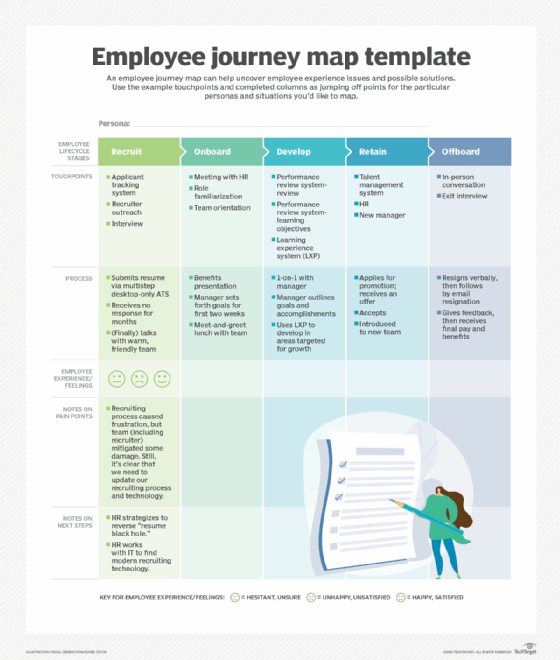How to design an employee journey map (with template)
Creating an employee journey map is an important step to improve the employee experience. Learn how HR and business leaders can use these maps to better understand the needs of different segments and personas.
As organizations compete for customers' dollars, focusing on the employee experience is critical. Creating an employee journey map is one way to uncover problem areas and solutions.
At its simplest, an employee journey map is a graphical image that represents the organizational path, or moments that matter, for a particular type of employee. For example, the same map might not be suitable for both a salesperson and a software engineer. An employee journey map can also include the candidate journey through the recruiting and hiring process.
Read on to learn more about an employee journey map and how to get started.
What is an employee journey?
An employee journey is the path a candidate takes from the time of their application to an organization through their exit from that organization. Employee experience is their feelings about everything that constitutes that path or specific feelings about specific touchpoints.
The touchpoints that have the most impact on that experience are described as moments that matter, and these are the most important things to include in an employee journey map.
What is an employee journey map?
As an HR leader, you will likely build a team of department leaders and other stakeholders to create an employee journey map.
An employee journey map can be a high-level comprehensive overview of the employee experience from recruitment to training to final offboarding, as shown in the employee journey map template below. It can also depict a particular part of the journey, such as its pain points -- stages that cause problems. Employee journey maps are also likely to include specific information about the touchpoints you're focusing on, ratings of a particular interaction and next steps.
It's also important to remember that creating an employee journey map is not a one-and-done process.
Why are employee journey maps important?
An employee journey map is an important tool for understanding the employee experience. Working with other stakeholders, your HR team can use the map to identify specific areas for improvement throughout each stage of employment and then create new strategies based on employee feedback.
Encouraging employee feedback can help improve employee satisfaction, which can result in higher retention rates and improve employee engagement. Engaged employees can become ambassadors for the employer brand, helping attract more talent.
Employee journey map template
No two roles are alike, so every employee journey map will be slightly different. However, this template can help you get started creating your own map. It uses the employee lifecycle as the basis for a map's structure. The following template offers some objectives for major touchpoints of the employee journey as well as some strategies and methods to follow. The employee experience can then be rated using the feelings key. The notes section enables your team to evaluate what went wrong or right and identify next steps.

5 key stages of an employee journey map
Here are some steps that HR teams should include in all employee journey maps.
1. Recruitment
Recruitment is the first step for all employees' journeys.
Treating candidates with respect is critical. One way to do this is by making sure the application process is easy to complete on mobile devices, which can help prevent candidate frustration.
Another important strategy for treating candidates with respect is providing status updates that tell candidates whether the company is still considering them for the position. "Ghosting" is one of the top complaints from candidates, so timely communication is important.
2. Onboarding
The onboarding process can be overwhelming for new hires with myriad tasks to complete, including understanding their new benefits, completing forms and getting to know colleagues. Getting onboarding right is critical, as it sets the tone for the remainder of the journey.
Assigning a co-worker to serve as the new hire's "buddy" is one way to potentially improve the onboarding experience.
3. Development
Employees don't want their careers to stagnate, so providing opportunities for professional development is arguably the most important stage of the employee journey.
Offering new skills training, paying for professional certifications and recommending qualified employees for promotion are integral to this stage.
4. Retention
Satisfied employees who are acknowledged and rewarded for their contributions are more loyal to their employer and less likely to look for another position, which helps improve employee retention.
As discussed previously, providing employee development opportunities and acting on employee feedback are just some of the ways to improve employee retention.
5. Offboarding
HR departments must handle the offboarding process in a way that ensures the departing employee is treated with dignity. Empathy is particularly important with laid-off employees, who are likely experiencing a range of emotions.
Meanwhile, employees who are leaving voluntarily for another job are more likely to speak well of their former employer if the offboarding process goes smoothly. A good offboarding process might lead to the worker being open to returning and becoming a boomerang employee.
5 steps to create your own employee journey map
Follow these steps to get started creating an employee journey map.
1. Understand your 'why'
As an HR leader, you serve a crucial role in advocating for the employee experience and driving the mapping process. But, as with any map, you need to know where you want to go before you understand the kind of map you need.
Work with a team that includes leaders from other departments to decide what you hope to accomplish with the mapping process.
Initially, you can start by outlining the map by hand to easily make adjustments and then build it out from there. While some organizations might want a complex map that covers all touchpoints, pain points and potential strategies, others might want a simple, straightforward map that identifies the most important touchpoints of an employee's journey from beginning to end (as with the template). You can adjust the template based on these requirements.
2. Decide on personas to map
Once you have identified goals, use the employee journey map template to identify the employee personas or segments whose journeys you want to map, since each experience will be unique.
For example, IT teams will have a different journey than the sales teams, and an entry-level employee's touchpoints and pain points will be different than those of a C-level leader.
While you don't need to create a different employee journey map for every single worker, segmenting employees and then building personas is critical to understanding employee pain points and potential improvement strategies.
3. Identify touchpoints
An important step in creating an employee journey map is to plot the most important touchpoints for each persona or segment you're mapping or to focus on specific issues. These moments that matter include critical junctures in the employee journey, from the first moment of contact as a candidate to the offboarding experience.
Important touchpoints also include onboarding, employee performance reviews and training. More specific ones could be how the organization handles life events, such as a new baby, or problem areas, such as a lack of raises or processes for dealing with difficult employees or managers.
4. Gather feedback
Reach out to employees to identify which touchpoints matter most and to get a fuller understanding of each one. For example, you'll want to identify what the employee wants to accomplish at each touchpoint and the pain points involved.
To gather feedback, you can interview managers and employees in person or send out a short poll. You might want to gather employee feedback from specific types of workers -- such as high performers or those who quit soon after onboarding -- to uncover critical issues and put them in your map.
Many HR platforms can collect employee feedback, and some can use data analytics to identify common themes across the feedback.
5. Keep the map up to date
Creating an employee journey map is not a one-and-done process, since change is the rule, not the exception.
Conduct an employee engagement survey periodically to gather feedback on the employee experience and enable important events to trigger new discussions. For example, hold exit interviews to gather feedback on an employee's experience at the company, including which pain points were most responsible for the decision to leave.
Creating an employee journey map is not an end unto itself, so it's important to understand how to use a journey map to boost employee experience.
Lynda Spiegel is a freelance writer and former global HR executive for financial services, telecommunications and SaaS companies.
Rachel Meltzer also contributed to this article.






